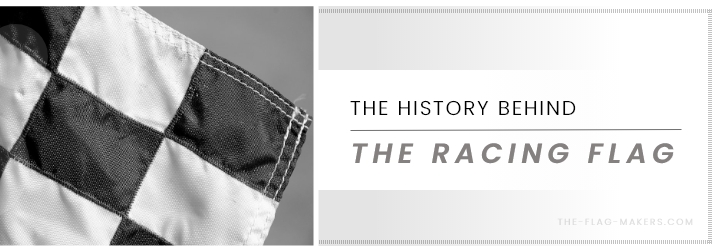Origins of the Racing Flag
You can find custom flags just about anywhere. You can find them flying on poles outside government building, flapping in the wind outside businesses, and they are a staple at many special events.
You can even find them on the racetrack!
Although flags share many things in common, they are all created for different reasons. When it comes to racing flags, their history is all about communicating with the racers on the track.
The history of racing and racing flags
Automobile racing goes all the way back to the 1800’s. The first true race was held in France in 1895. They reached top speeds of just 24.15 kph. Trophy races began in the 1900’s, and that’s also when auto racing became an international sport.
The use of auto racing flags goes back almost as far as the very first race. The famous checkered flag design debuted at the Glidden Tours in 1906. They have such a long history because racing flags are used for more than just decoration—they are used to communicate with the drivers.
Different flag designs are used for different reasons, but they are all used to communicate quickly and efficiently with drivers about the condition of the track and the state of the race.
There is no universal system for racing flags and their meanings. Different motorsports have slightly different meanings for their flags, although they remain quite similar. However, each series has standardized the use of their flags so they are consistent between races.
FIA-sanctioned races are commonly held all over the world, so many other motorsports have adopted the standardized usage of their flags. However, some North American racing bodies, like NASCAR, have their own standardized meanings for each flag.
Types of flags and their meanings
The most common racing flag that those not interested in the sport will recognize is the black and white checkered flag. It is universally used to signify the end of a race, although FIA-sanctioned races consider it the signal for the end of the session. NASCAR goes a little further by adding a green checkered flag into their arsenal, which signifies the end of a racing stage.
Additional racing flags and their most common meanings include:
- Green: Signals the start of a race. It can also signal the end of a caution period.
- Yellow: Generally means caution. It can identify a hazard near the track. Double flags can signify full-course caution in a NASCAR race or a hazard blocking the track in an FIA-sanctioned race.
- Yellow and Red Stripes: Universally signals the presence of debris or slippery fluids on a road course.
- Blue: Represents courtesy to give way to faster cars approaching. In a NASCAR race, the flag also contains a diagonal yellow stripe.
- White: In FIA-sanctioned races, it indicates a slow-moving car. NASCAR races use it to signify the final lap.
- Red: Signifies conditions are too dangerous to continue.
- Black: FIA-sanctioned races use a plain black flag to signify a disqualification, while NASCAR uses it to tell a driver to return to the pits.
Additionally, a pink 60 flag is waved at some FIA-sanctioned races to tell drivers to slow down to 60 km/h, or 37 mph.
Flags in motorcycle racing are a little different. For example, a while flag with a red cross indicates that medical attention is needed, while a white flag with a black circle indicates glare from the sun ahead.
Other kinds of racing flags
The flags used on the course are generally hand flags that are waved by a person to communicate a message to the drivers, but hand flags can be used in the stands too. However, care should be taken to make sure that their design is very different from the flags that are being waved on the course to communicate with drivers to avoid any confusion. They are a great way for spectators to demonstrate their support of their favorite drivers.
Many clubs and associations exist for those who love the sport of racing. At many of those meetings and events, flags are used. For example, Corvette clubs are so popular that they have their own universal design.
The professionalism of the flags is extremely important if you are planning on using flags at a race. Turn to The Flag Makers for all of your racing flags. Not only do we have an online flag designer, so you can create your own, we also have standardized designs on file that are constructed out of heavy-duty materials so you can use your flags over and over again.


